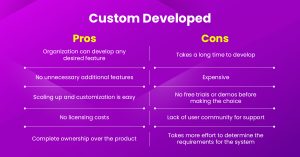Making decisions is a crucial part of running a successful business. These decisions may be strategic or tactical, but all of them have a direct impact on the performance of the company. Digital transformation is a strategic decision wherein organizations leverage new technologies to reposition themselves to navigate their respective markets. One of the biggest dilemmas companies face while choosing the right software to increase business value is whether to choose Commercial-Off-The-Shelf (COTS) software or to get a software development partner to build them a Custom-Developed one for better performance. COTS and Custom Developed software have their own benefits, but not all businesses are compatible with them both. It is mandatory for organizations to analyze their needs and choose between the two. This blog is meant to guide you to choose the right option based on your situation.
Organizations must realize their needs and take into account these four factors before choosing between COTS and Custom Developed:
- Business needs
- Budget
- Timeline
- Long-term goals
Let us analyze the pros and cons of custom-developed and commercial off-the-shelf software to help you determine the right option for you.
Custom Developed Software
Software vendors who build specialized software for a specific industry and cannot rely on cookie-cutter solutions should look to developing custom-developed software. Organizations with business processes for which there are no suitable COTS should also have their software custom made. Custom-developed applications are designed to maximize the output and increase the level of delivery. This approach will enable organizations to adopt cloud-native application development which employs service-based architecture, microservices, and containers. These applications do not have unnecessary features like the commercial off-the-shelf ones. The development teams collaborate with the business leaders to determine the requirements for the system. This process may take a long time, but it pays off to diligently determine the requirements. All their features exist for a reason and they do not go to waste. The software developed will be cloud-native, easy to scale up, and customize according to your business needs. Another advantage of custom-developed software is that you own the complete rights over the product. This means that you can commodify the product to increase your revenue. There will also be no licensing costs that might add to your bill.
One of the downsides of custom-developed applications is that it will take a long time and more money to develop. The efforts to determine the requirements are high too. Since they are custom developed for one particular customer, they lack the user community for the support that can contribute to its improvement. Unlike commercial off-the-shelf software, custom-developed software does not come with free trials to help you to arrive at a decision.
Commercial Off-the-Shelf (COTS) Software
Commercial Off-the-Shelf software is suitable for businesses that are looking to cut costs. Companies usually choose COTS only if they see them successfully improving the business value of another company. Since their cost is distributed among many users, commercial off-the-shelf software is cost-effective. Users can try the free trials COTS developers offer and decide whether to subscribe to them or not. This will help you to avoid buying software less suited for you and save you time and money. Off-the-shelf software undergoes constant updates and enhancements due to the improvements from customer feedback. These results in quality improvement and ensure betterment in the future. This approach to software development also ensures large customer support offerings which that will come in handy whenever there are problems with the application. Unlike custom-developed software that takes months to develop and implement, COTS can be implemented immediately after purchase.
While COTS is cost-effective and easy to implement, it is hard to customize. It is also less flexible and can sometimes become incompatible with business decisions. Changes to the business model might make the application obsolete. Another important drawback is that the COTS applications usually tend to have lots of unnecessary features. This is because the applications are usually developed for a wide range of customers. Since these applications are developed by a third party and sold for a fee, you cannot own the rights to the system. You can only subscribe to the software and use it until expiration. You might also have to pay for its up-gradation in the future.

Choosing between these two approaches is a classic “build or buy” decision and is surely a complex affair. This is because the impact of their implementation cannot be predicted. The best way to go about it is to have a mix of both in your organization. But decision-makers must be cognizant of their needs, budget, and goals to arrive at the conclusion. COTS might seem like a simple solution, but this approach also involves a lot of configuration and integration. Custom-developed might be well suited to achieve your long-term goals, but they can be expensive and take a long time to develop. So it is up to the organizations to analyze their pros and cons and choose the best option for them.







Comments